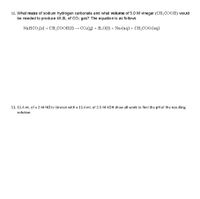
Chemistry
10th Edition
ISBN: 9781305957404
Author: Steven S. Zumdahl, Susan A. Zumdahl, Donald J. DeCoste
Publisher: Cengage Learning
expand_more
expand_more
format_list_bulleted
Question
Can this be solved with work, please? thank you!

Transcribed Image Text:10. What mass of sodium hydrogen carbonate and what volume of 5.0 M vinegar (CH,COOH) would
be needed to produce 45.0L of CO2 gas? The equation is as follows
NaHCO,(s) + CH,COOH(1) → CO.(g) + H,O(1) + Na (aq) + CH,COO(aq)
11. 11.4 ml ofa 2 M HCl is titrated with a 11.4 mL of 2.5 M KOH show all work to find the pH of the resulting
solution.
Expert Solution
This question has been solved!
Explore an expertly crafted, step-by-step solution for a thorough understanding of key concepts.
Step by stepSolved in 3 steps with 1 images

Knowledge Booster
Learn more about
Need a deep-dive on the concept behind this application? Look no further. Learn more about this topic, chemistry and related others by exploring similar questions and additional content below.Similar questions
- MISSED THIS? Watch KCV 9.6; Read Section 9.6. You can click on the Review link to access the section in your e Text. When 1 mol of a fuel is burned at constant pressure, it produces 3453 kJ of heat and does 12 kJ of work. Corre -acause IH Part B IMELIORY i transferred system to t wallalansi 2 Subs What is the value of AH for the combustion of the fuel? Express your answer to four significant figures.arrow_forwardI need answer to this question ASAP, please. Thank you. Note: it is grade 12 chemistry so pls don't give me a university-level solution so that I can understand.arrow_forwardwhich of the following processes would work be zero? a. boiling water in a conduction cooker b. boiling water in an open casserole c. boiling water in a pressure cooker d. boiling water in a vacuumarrow_forward
- Need answers and explanationarrow_forwardORT SHEET Heat of Neutralization EXPERIMENT elemsboomfchg lom 12 A. Heat Capacity of Calorimeter 1. Temp. of calorimeter and water before mixing 2. Temp. of warm water °C 22.0 39,0 30.3 3. Maximum temp. determined from your curve °C 4. Heat lost by warm water (temp decrease x °C 50.0 g x 4.184 J/K-g) = 02), 5. Heat gained by cooler water (temp. increase x 50.0 g x 4.184 J/K-g) = 30,3 22.0)x 13626J s0.0gmpi S0.0gy 6. Heat gained by the calorimeter [(4) – (5)] = 7. Heat capacity of calorimeter: heat gained by the calorimeter temperature increase J/K 3. Heat of Neutralization of HCl-NaOH 22.2 22.2. °C . Temp. of calorimeter and NaOH Temp. of HCI AT determined from your curve after adding HC1 °C to the NaOH Heat gained by solution (temperature increase x ON 100 g x 4.184 J/K-g) = 9977.8J %3D Heat gained by calorimeter (temperature increase x heat capacity of calorimeter) = J %3D Total joules released by reaction [(3) + (4)] = Tight O 2018 Pearson Education, Inc.arrow_forwardShow the relationship between two variables, Ea and ΔHo ?arrow_forward
- A gas-forming reaction produces 1.65 m^ of gas against a constant pressure of 160.0 kPa. Calculate the work done by the gas in joules.arrow_forwardPelcomtel fall 2020-Compatibility Mode Word Search eferences Mailings Ma Ma djaH 15 E E AaBbCeI AaBbCd AaBbC AaBbC Aab - -E E & EE 1 Normal 1 No Spac. Heading1 Subte Paragraph sayas 14 Which of the following is an example of something with potential energy 1 a ball falling through the air 2 throwing a dart at a dart board 3. a ball rolling down a slide 4 an arron flving through the air a boulder at the top of a clitfarrow_forwardn 17 of 41 > Consider a cloudless day on which the sun shines down across the United States. If 2751 kJ of energy reaches a square meter (m²) of the United States in one hour, how much total solar energy reaches the entire United States per hour? The entire area of the United States is 9,158,960 km². solar energy per hour: kJ/h 1037 10 A átvarrow_forward
- 1. KMNO4, HO“, heat 2. H3O* MAR 21arrow_forwardFor similar light intensity, compact fluorescent bulbs use about 25% of the energy of incandescent bulbs. Let's say you replaced a bulb of 100W with a fluorescent bulb and that your utility charges $0.15/kW-hour. How many dollars would you save in electricity in the 10,000-hr. lifetime of the bulb?arrow_forwardA 139-lb student races up stairs with a vertical height of 5.5 m in 5.5 s to get to a class on the second floor. How much power in watts does the student expend in doing work against gravity?arrow_forward
arrow_back_ios
SEE MORE QUESTIONS
arrow_forward_ios
Recommended textbooks for you
 ChemistryChemistryISBN:9781305957404Author:Steven S. Zumdahl, Susan A. Zumdahl, Donald J. DeCostePublisher:Cengage Learning
ChemistryChemistryISBN:9781305957404Author:Steven S. Zumdahl, Susan A. Zumdahl, Donald J. DeCostePublisher:Cengage Learning ChemistryChemistryISBN:9781259911156Author:Raymond Chang Dr., Jason Overby ProfessorPublisher:McGraw-Hill Education
ChemistryChemistryISBN:9781259911156Author:Raymond Chang Dr., Jason Overby ProfessorPublisher:McGraw-Hill Education Principles of Instrumental AnalysisChemistryISBN:9781305577213Author:Douglas A. Skoog, F. James Holler, Stanley R. CrouchPublisher:Cengage Learning
Principles of Instrumental AnalysisChemistryISBN:9781305577213Author:Douglas A. Skoog, F. James Holler, Stanley R. CrouchPublisher:Cengage Learning Organic ChemistryChemistryISBN:9780078021558Author:Janice Gorzynski Smith Dr.Publisher:McGraw-Hill Education
Organic ChemistryChemistryISBN:9780078021558Author:Janice Gorzynski Smith Dr.Publisher:McGraw-Hill Education Chemistry: Principles and ReactionsChemistryISBN:9781305079373Author:William L. Masterton, Cecile N. HurleyPublisher:Cengage Learning
Chemistry: Principles and ReactionsChemistryISBN:9781305079373Author:William L. Masterton, Cecile N. HurleyPublisher:Cengage Learning Elementary Principles of Chemical Processes, Bind...ChemistryISBN:9781118431221Author:Richard M. Felder, Ronald W. Rousseau, Lisa G. BullardPublisher:WILEY
Elementary Principles of Chemical Processes, Bind...ChemistryISBN:9781118431221Author:Richard M. Felder, Ronald W. Rousseau, Lisa G. BullardPublisher:WILEY

Chemistry
Chemistry
ISBN:9781305957404
Author:Steven S. Zumdahl, Susan A. Zumdahl, Donald J. DeCoste
Publisher:Cengage Learning

Chemistry
Chemistry
ISBN:9781259911156
Author:Raymond Chang Dr., Jason Overby Professor
Publisher:McGraw-Hill Education

Principles of Instrumental Analysis
Chemistry
ISBN:9781305577213
Author:Douglas A. Skoog, F. James Holler, Stanley R. Crouch
Publisher:Cengage Learning

Organic Chemistry
Chemistry
ISBN:9780078021558
Author:Janice Gorzynski Smith Dr.
Publisher:McGraw-Hill Education

Chemistry: Principles and Reactions
Chemistry
ISBN:9781305079373
Author:William L. Masterton, Cecile N. Hurley
Publisher:Cengage Learning

Elementary Principles of Chemical Processes, Bind...
Chemistry
ISBN:9781118431221
Author:Richard M. Felder, Ronald W. Rousseau, Lisa G. Bullard
Publisher:WILEY